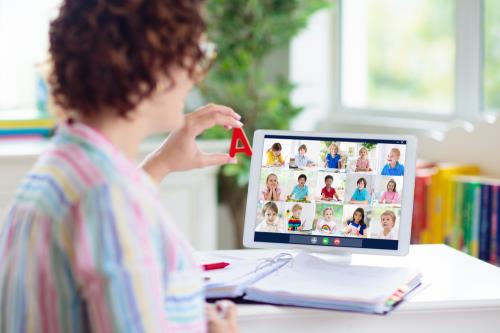21 Mar 2021

By Mark Richards,
The re-opening of schools may well be imminent, but it is highly likely that remote teaching will remain a part of the ‘new normal’ of education. Teachers adapted swiftly to the new demands placed on them with online learning, but it has been a steep learning curve. So, how can we enhance remote teaching and learning in the future?
Increase participation
Many teachers have been left with a sense of frustration regarding student engagement in online learning. Having gone past the ‘novelty stage’ of Zoom/Teams lessons, it seems that many students have cottoned onto the fact that it’s easy enough to hide away during lessons that are online. We’re not talking about those who cunningly log-on and then move across the room to start playing on their Xbox – although that has happened! No, the pressing problem is the student who realises that in the online environment it is much easier to ‘be there but not be there’ than in the traditional classroom. You can be in the room, but with much remote learning being dominated by teacher talk, it’s simple enough to slink away into the digital shadows and not participate much, if at all, in the lesson.
Skilled teachers have become adept over the years at increasing student engagement in the conventional classroom. There are a plethora of strategies and approaches that the teacher can employ to increase participation when the lesson is face-to-face in the classroom. However, this is a tougher task with online learning.
So, what can teachers do?
Make online learning as interactive as possible
That’s the answer. Teachers should try to make online learning as interactive as they can. It stands to reason that students need to be given opportunities to apply and actively process the lesson content that is being presented to them. If the student’s role is relegated to one of simply reading or listening, online learning will always remain a poor alternative to face-to-face teaching. And this needn’t be the case.
There’s a tendency, natural enough, for teachers to ‘lead from the front’ with remote teaching – more so than they would do in a normal classroom environment. There are plenty of ways that interactivity can be brought into online lessons, from quizzes to digital whiteboard. Teachers should fully explore the capabilities of the online learning platform so that a range of engaging activities can be incorporated into the lesson.
Keep things simple
This doesn’t mean that the work should be easy or that the challenge bar should be set too low. However, giving simple and clear instructions and having similarly clear expectations are always important in teaching. In a face-to-face ‘physical’ classroom environment, the alert teacher will gauge students’ understanding and intuitively assess the mood of the room. In an online environment, it is much more difficult to do. Therefore, simplicity is best. Teachers should avoid the temptation to use too many different apps, platforms and resources. Instead, they should develop clear routines and introduce manageable chunks of new content sparingly. It’s all too easy to overload and overwhelm students by bombarding them with content, information and instructions.
RELATED POSTS
1- How to Make a Remote Learning Lesson Plan
2- How Learning Management Systems are Revolutionizing Education
3- Achieving the illusive work-life balance in teaching
4- How to encourage students to learn something new in Summer holidays?
5- Financial protection for teachers during Covid-19 pandemic
We encourage our readers to share their knowledge.
Do you have an idea, view, opinion or suggestion which would interest others in the education sector?
Are you a writer? Would you like to write and have your article published on The Educator?
If you are connected with the education sector or would like to express your views, opinion on something required policymakers’ attention, please feel free to send your contents to editorial@theeducator.com